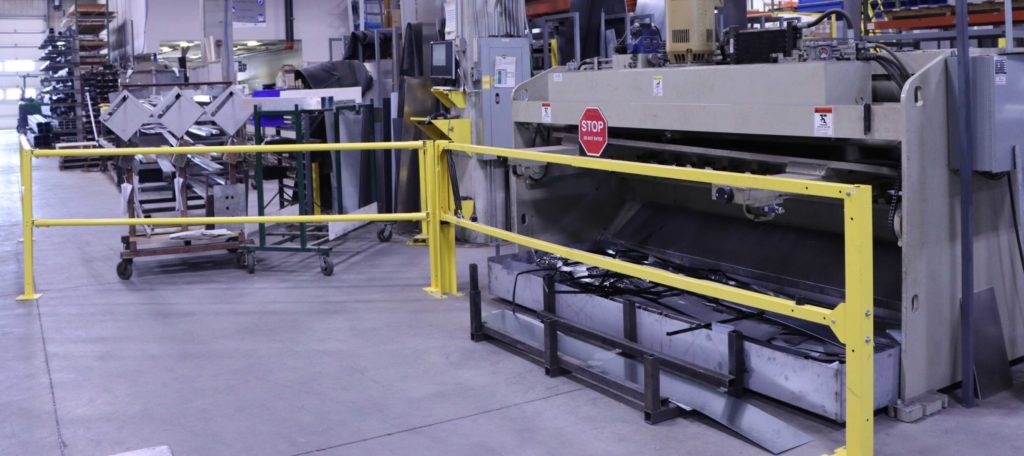 It may seem like a paradox, but the more automation is introduced into industrial and manufacturing facilities, the more important it becomes to keep workers safe around machines. The less direct interaction humans have with mechanical technology, the more likely we are to take our safety around them for granted.
It may seem like a paradox, but the more automation is introduced into industrial and manufacturing facilities, the more important it becomes to keep workers safe around machines. The less direct interaction humans have with mechanical technology, the more likely we are to take our safety around them for granted.
The hazards of machinery are well known: each year moving machine parts are one of the main causes of workplace injuries, from crushed fingers and hands to burns and blindness. When the operation of equipment has the potential to cause harm to operators or anyone else in the vicinity, proactive steps must be taken to eliminate or at least control the threats to human safety.
The Facts:
On OSHA’s list of the agency’s most frequently cited standards, “machine guarding” is in the top 10. Today, this term is being replaced by “perimeter guarding” or simply “restricting access,” but in general, all of these descriptions mean the same thing: keeping workers away from dangerous areas or machines. Whatever you call it, its position on OSHA’s list puts it in significant company, along with citations for things like fall protection, respiratory protection, issues with ladders, control of hazardous energy and more.
Machine guarding / perimeter guarding for general industry is covered under the OSHA 1910.212(a) standard, and it includes regulations for all machines, as well as specific standards for things like woodworking, mills, abrasive wheels, power presses, forging machines and more. 1910 Subpart R also covers machine guarding for additional industries such as textiles, baking and telecommunications.
The Challenge:
Expectations for human safety around industrial machines continue to rise, with standards and regulations following suit. While training, signage and good communication are still important parts of worker safety, the general consensus is that they are not enough. Additional steps must be taken to keep people safe, and machine guarding is the key. But how can hazardous machines be guarded in a busy industrial environment when they all have unique functions, dimensions, locations and access requirements?
The Solution:
By developing perimeter guarding products that work together as a flexible system, PS Safety Access™ helps industrial and manufacturing facilities keep workers and visitors safe without compromising productivity. These professionally engineered products work together to support your team, providing access when needed and keeping people away when it isn’t.

When you need products to address two of OSHA’s biggest concerns – fall protection and machine guarding – trust the innovative professionals at PS Safety Access:
EdgeSafe® Smart Gates
Created to improve employee and customer safety the smart way, the EdgeSafe® Smart Gate provides flexible sizing to fit virtually any situation. It is ideal for a variety of applications, including perimeter guarding, equipment protection, fall protection, ground-level traffic/pedestrian control, deployment as an aisle violator and crowd control where forklift traffic (or other machinery) is present. It lifts 90 degrees without pinch points for easy one-handed operation and features Slam-Proof™ technology to control the closing speed and noise.
EdgeSafe® Safety Railings
 No ordinary railing, the EdgeSafe Safety Railing acts as the foundation for a complete safety system in any industrial facility. It employs a universal, omnidirectional bracket, making it flexible enough to address almost any application at virtually any angle (unlike a typical straight or 90-degree railing)! It is simple to assemble and install, making it the perfect solutions for machine guarding, floor traffic control and even protection for edges on mezzanines.
No ordinary railing, the EdgeSafe Safety Railing acts as the foundation for a complete safety system in any industrial facility. It employs a universal, omnidirectional bracket, making it flexible enough to address almost any application at virtually any angle (unlike a typical straight or 90-degree railing)! It is simple to assemble and install, making it the perfect solutions for machine guarding, floor traffic control and even protection for edges on mezzanines.
EdgeSafe® Personnel Access Gates
 This floor-level gate was developed specifically to warn personnel about dangerous or off-limits areas. It swings bidirectionally (both ways) to allow pedestrians to enter or exit an access-restricted area. As an example of how it can be used, the EdgeSafe Personnel Access Gate can protect areas in which personnel and forklifts share the same traffic spaces. It makes no noise when it closes, and because the free end does not contact the railing, the opening width is variable.
This floor-level gate was developed specifically to warn personnel about dangerous or off-limits areas. It swings bidirectionally (both ways) to allow pedestrians to enter or exit an access-restricted area. As an example of how it can be used, the EdgeSafe Personnel Access Gate can protect areas in which personnel and forklifts share the same traffic spaces. It makes no noise when it closes, and because the free end does not contact the railing, the opening width is variable.
You can see OSHA’s full list of the top 10 most frequently cited standards here: https://www.osha.gov/top10citedstandards. The agency’s specific machine guarding information can be found here https://www.osha.gov/machine-guarding.
If you’d like to learn more about the products from PS Safety Access, contact us here.